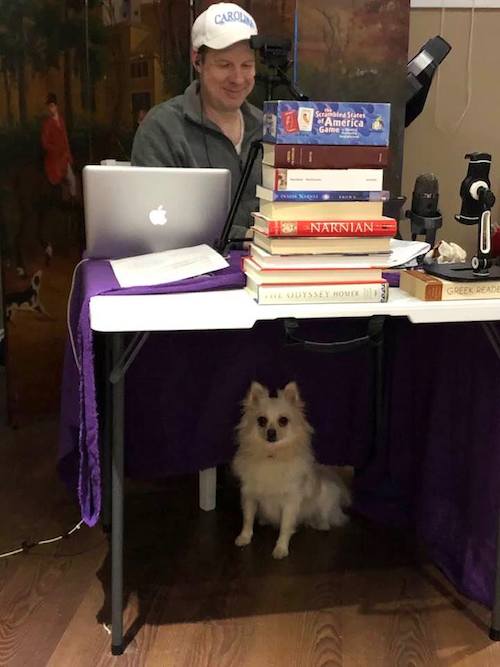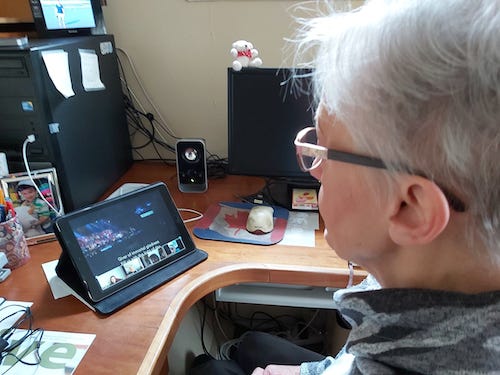After church on Sunday, the post-worship conversation turned to how we’re all holding up and adapting through the first fortnight of these pandemic days. It was good to check in and be checked in on. One member lamented the disappointment and stress of having to cancel her son’s wedding. I shared the psychological weight I feel with the closing of the U.S / Canadian border, knowing that I could not physically get to my mother or my in-laws should the need arise. We also voiced “silver linings.” One couple returned from Mexico to two-weeks of mandatory quarantine to find their fridge already stocked by family and friends. Another member commented on the change in the political tone: the usual partisan rancour giving way to a more civil discourse stemming from a growing realisation that, no matter our positions or convictions, we really are all in this together.

It was good conversation, the type of conversation that helps make church church.
We then waved goodbye until next Sunday. But instead of rounding up my kids, collecting my coat, and tracking down my travel mug, I simply clicked “End Meeting” and made my way back upstairs to the kitchen to refill my coffee cup.
Like other pastors across North America and around the world, my staff and I have devoted much of our time and energy in recent days to figuring out how to move Sunday morning from the sanctuary into cyberspace. That will be our exclusive gathering place and worship space for the coming weeks (perhaps months). It’s not a new frontier, exactly, in 2020; but it is uncharted territory nonetheless. For churches like ours who have not webcast their services prior to now, culturally we’re having to make a quantum leap from the late 1980s into the 21st century.

One of the shiniest “silver linings” I see in this forced adaptation is that, as a pastor and a leader, I’ve been thinking more intentionally about connection than about programming or sermon craft. A chunk of that deliberation has come in the form of figuring out online platforms and camera positions and lighting angles; but all of it has been in service of the question: how do we continue to be in fellowship as the body of Christ across the divides of social-distancing and self-isolation? In short, how do we stay connected? This is the fundamental question of this moment in time for the Church.
“Connection is what the church’s best, truest self has at its core: a bond, a mission, an identity born from and built upon love of God and love of neighbour.”
In truth, questions of connection are foundational for the Church at all times. Connection is what the church’s best, truest self has at its core: a bond, a mission, an identity born from and built upon love of God and love of neighbour. We are a body, after all, Paul declares – Christ’s body, in fact: the gospel incarnate in our particular time and place. We are many members who belong to Christ and thus belong to one another in the name of Christ. If this pandemic helps us to recover that, it will prove a washed-up treasure that will enrich us and sustain us after the storm passes.

There’s a real irony in all of this, of course. Loneliness has been growing within Western societies to such an extent that the United States and Britain now recognise it as a public health concern. The same economic, political, and technological evolutions that have enabled me to read newspaper articles from New Zealand on my laptop from the comfort of my couch have separated me from the folks who likewise sit on their couches glued to their screens across the street. That social distancing did not begin with the Coronavirus. Perhaps, however, this pandemic will prove disruptive enough to start bringing us back together. Perhaps it’ll jog our memories: togetherness doesn’t just happen. We have to work at it.

The post worship conversation, the chat box banter during the service – the connection – turned out to be the real gift of our first real online worship experience: to see and be seen, to hear and be heard, human face to human face, human voice to human voice, even if we needed a screen and a mic to facilitate. The content delivered by the lighting angles and the camera positions through the online platform wasn’t bad, either, and will continue to matter as it does on any given Sunday. But in the coming weeks (perhaps months) the connection we help to cultivate with each other, and to God through each other, will be what really helps us to ride out this storm.
So, fellow pastors, as another week begins and we debrief and continue to experiment with camera positions and lighting angles for Sunday worship, let’s devote at least as much time figuring out how to take coffee hours, game nights, and life groups into cyberspace – all the things beyond liturgy and sermons and music that make church church. They’re foundational, and we’re going to need them.


























